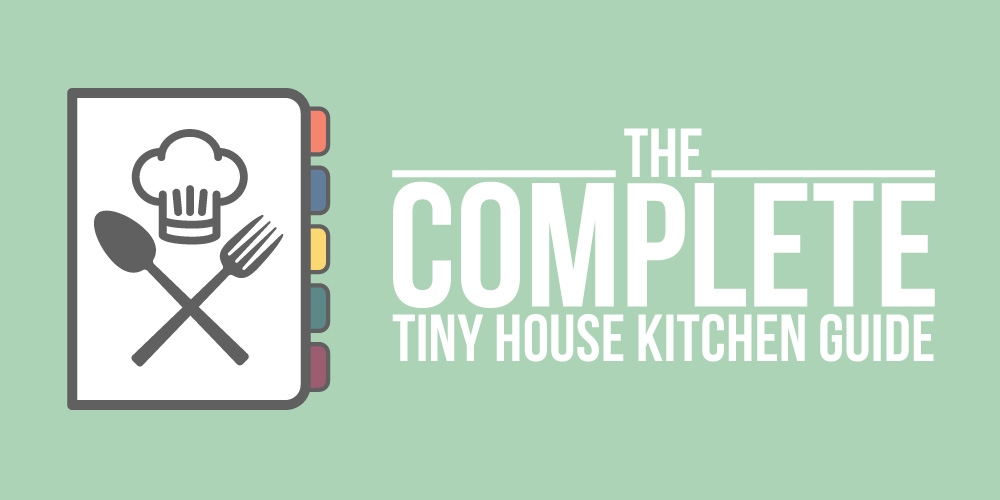 When I built my tiny house, I knew planning my tiny house kitchen was critically important. After all, the kitchen is usually the center of the home—the command center.
When I built my tiny house, I knew planning my tiny house kitchen was critically important. After all, the kitchen is usually the center of the home—the command center.
In a small space, having a well-organized and clear setup is critical. Even if you don’t like to prepare or cook food (or prefer to pop an instant meal in the microwave), your kitchen will still get used regularly. I, for one, enjoy cooking and food prep. In my tiny home kitchen, I can’t really accommodate giant meals or parties, but making a delicious meal for one or two people is easily doable and fun. I always keep my tiny house kitchen clean and ready for action.
Questions about tiny house kitchens are some of the most frequent queries I get. Everyone worries about how they should set up their kitchen, what type of appliances they’ll need, and how to make their tiny house kitchens functional, useful, and comfortable. I decided to put together this guide to tiny house kitchens to help you set up a kitchen where you’ll love (or at least, not hate) to cook.
A Video Tour of My Tiny House Kitchen
For a more in-depth look at my tiny kitchen, please enjoy this video tour. In this tour, I’ll walk you through my tiny house kitchen, and what I find useful.
11 Things What I Wish I Knew When I Set Up My Tiny House Kitchen

Now, I’ve had several years of prepping, cooking, and eating in my tiny house kitchen, which has been enough time to learn a few things I wish I’d known BEFORE I set up my tiny house kitchen.
Don’t get me wrong—my kitchen is great (and some of what I didn’t know ended up working out anyway as happy accidents), but of course, looking back, there are always adjustments you’d make.
1. Understand How Much Kitchen You Need

If you’re a person who microwaves a burrito a couple times a day, then you probably don’t need a huge kitchen. If you look at people who live in tiny apartments (for example, in New York City), they may not even have a kitchen in their apartment since each square foot is so expensive. They may get by with a microwave and a hotplate, a small fridge or a little kitchenette. So, really assess how much kitchen you need.
For me, I cook all my meals from scratch, so I knew I needed a fully functioning kitchen. I had to fit a lot in a small space. For my needs, I have a stovetop, a fridge, a sink, and counter space for prep. I don’t have a dishwasher, microwave or an oven. Being off the grid, I knew the power requirements for those appliances was high, and I’m okay with handwashing my dishes. Similarly, I don’t bake. I love to cook, but I don’t need an oven. (I have a toaster oven, which I rarely use).
2. Recognize the Challenges of Having a Small Kitchen

The kitchen is a very specialized space. Tiny house builders tend to give a lot of square footage to the kitchen. With other single-use rooms, like the bathroom, the tendency is often to go as small as possible. While the same applies to the kitchen, you’ll want to be sure there’s plenty of room to make it functional. Only you know what you need in terms of space. Keep in mind, it’s easier to live with a plan that’s a little too big, rather than planning a kitchen that ends up too small.
3. Figure Out Exactly What You Need to Put in Your Kitchen, First

Before I started to design my kitchen, I made a whole grocery list of what I wanted in my pantry. This was one of my smartest ideas while planning my tiny kitchen. I was able to measure everything I would want and need regularly, and I built my pantry cupboard to accommodate it all.
Similarly, I went out and bought my pots and pans, as well. I measured all of them and designed around them so they would all fit. After all, nothing’s worse than finding out your cookware doesn’t fit into your tiny home kitchen cupboards, and you must store it in another spot (or go out and buy all new).
Buy dishes, silverware, and utensils—everything you’ll need to equip your tiny house kitchen. Then plan around them.
4. Ditch the Gadgets

The kitchen is an area where there are hundreds of different gadgets out there. I used to gravitate toward a cool garlic press or a neat spice grinder. Then I realized you could do so much with good knife skills and the basic tools; you don’t need all those extra bells and whistles.
Once I brushed up on my knife skills in the kitchen, I found I could do almost any job faster, better, and with more accurate results with a knife alone. I really didn’t need a whole drawer of extra tools and one-trick-ponies. After living in my tiny house for a while, I’ve pared back more and more, especially as I’ve moved toward a minimalist lifestyle and approach.
5. Clear the Counters

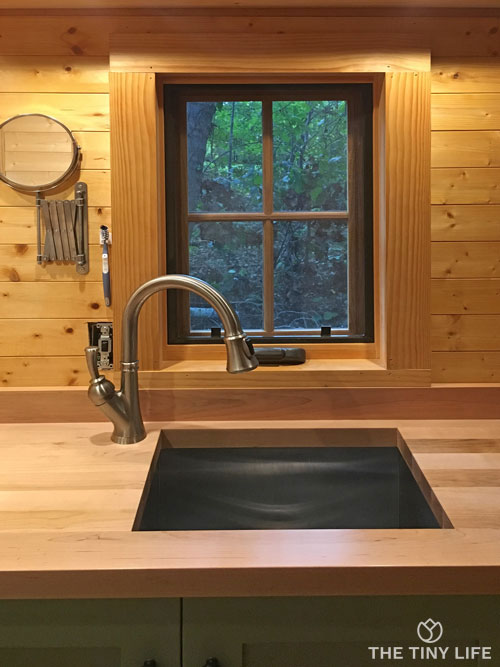 It’s easy to clog up your counter space with small appliances. After all, there are so many options out there—a bread maker, a toaster oven, a food processor, a big mixer…and the list goes on. I find it’s helpful to assess what you actually use on a REGULAR basis and ditch the rest.
It’s easy to clog up your counter space with small appliances. After all, there are so many options out there—a bread maker, a toaster oven, a food processor, a big mixer…and the list goes on. I find it’s helpful to assess what you actually use on a REGULAR basis and ditch the rest.
On my counter, I only keep a cutting board, there is nothing else kept on the counter regularly. I’ll pull out my blender (which does almost anything I’d need a mixer or food processor to do), an Instant Pot (replacing the need for a slow cooker), and a toaster oven all of which I store in my cabinets. That’s all I need or use regularly. You may find you need a microwave, or you prefer a food processor to a blender. Whatever you keep, be sure you really need it on your premium counter space.
I couldn’t use the first toaster oven I bought for my kitchen. It was a really nice $200 toaster oven (way more than I’d ever spent on such an item before). I plugged it in, and it pulled way too much power from my house. So it’s still in the box (and way past the return date). Carefully plan your purchases, especially for items taking up valuable spots on your counter.
6. Ventilation is Critical

When I cook, my house warms up quite a bit, so my air conditioning will kick on. Food smells permeate the entire tiny house. I would say about every third time I cook, my smoke alarm goes off—not because I’m lighting food on fire, but because it’s a lot of steam in a small space.
Plan plenty of ventilation in your tiny house. Now, this is a bit of a pain because you need an 8 or 9-inch vent tube to go through your entire wall. With a tiny house, this is challenging to fit in, so plan carefully. Ventilation is mandatory, so you’ll need to figure out how to work it into your design.
7. Remember Storage Areas

It takes time to plan tiny house kitchens that function well. In fact, you may want to let your design rest for a bit, before coming back to it. I find there are three areas people often forget in their planning: pantry space, an area for the garbage can, and an area for recycling. Figure out precisely what you want to store and then design around it.
After building my tiny kitchen and living in my house for quite a while now, I’ll admit I wish I doubled my pantry space (despite my minimalist approach to food storage). Even though I planned it all out, I still struggle with flexibility.
As I said above, purchasing your “go-to” items and measuring ahead really helps, but I found I even had to tweak things along the way to fit everything in my pantry. Chances are, even with the best plans, you’ll need to adjust once you’re living in the space.
8. Counterspace is Nice to Have

I planned a pretty big countertop space in my kitchen. It was important to me to have enough room that it didn’t feel cramped (but of course, to still fit within my space). Again, it’s because I like to prepare meals ahead, and I do quite a bit of chopping and work on the counter.
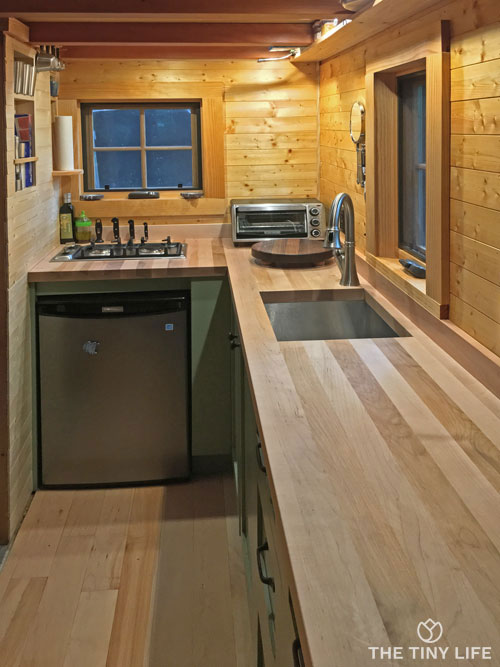 Other people I know plan more modular designs, where countertops pull out, fold-out, or move around to get bigger or smaller. While these approaches will work, I don’t suggest it for something you’ll need every day or even once a week. It’s kind of like a murphy bed, no one realistically makes their bed and folds it back every day, it just stays out the entire time and is awkward.
Other people I know plan more modular designs, where countertops pull out, fold-out, or move around to get bigger or smaller. While these approaches will work, I don’t suggest it for something you’ll need every day or even once a week. It’s kind of like a murphy bed, no one realistically makes their bed and folds it back every day, it just stays out the entire time and is awkward.
Once again, it comes down to how you want your kitchen to function. If you don’t do a lot of food prep, or if you find you’re the type of person who piles up mail, paperwork, or other items on your counter, you may want a small counter to eliminate that tendency. On the other hand, if you love working in the kitchen, give yourself enough room to chop and prepare your meals properly. Cooking will become much more pleasurable.
I also planned in a drawer for my utensils and tools. Some folks prefer a knife block or a crock of kitchen accessories on the counter (my knife block is built into my counter). Keep in mind, while it’s convenient to keep the tools right on hand, it will also begin to eat up your valuable space.
9. Plan Your Lighting Carefully

Lighting is so important throughout your tiny house, but especially in your kitchen. When I was planning my lighting, I was very careful to take a lot of time, and I put a lot of thought into the functionality of the lighting. I used LED puck lights and plotted out the layout. As a result, in terms of lighting, my tiny house is probably the most well-designed space I’ve ever lived in. There’s enough light, the switches are well laid out, and I can see in every area.
The LED lights are nice because they don’t kick off heat, and they’re low power (ideal for living off the grid or relying on battery power). They don’t take up a lot of space and depth, unlike a can light that has to be inset into the wall by about 12 inches. You may not have space in a tiny house, so surface-mount lights are great. Also consider what lights you want on dimmers or three-way switches and plan them out ahead of time.
10. Organization Will Keep You Sane

Organization is critical for tiny house kitchens, but also tiny houses in general. The thing about a tiny house is if ONE item is out of place, it will drive you nuts. I’ve found days when I toss my backpack on the floor, I’m bothered until I put it away.
When you live in a small space, you can’t ignore a mess. You can’t live in a tiny space unless it’s neat and tidy. I clean my entire house each morning. That may sound excessive, but honestly, with a tiny house, it doesn’t take long at all and I always feel like my space is calm, inviting, and organized. When you’re in a small space, even a little clutter makes it feel like a disaster zone.
In the kitchen, I created a wall organizer for the items I use every day (tinfoil, salt, pepper, hot sauce, cups, and measuring cups). I also planned open shelving tucked away where I keep all my dishes. The convenient aspect of a tiny kitchen is every item is within arm’s reach. Every item has a home, and keeping it tucked in the proper spot will make your life SO much less complicated.
11. Buy Items Meant to Last

I’ve found the kitchen is one area where I permit myself to splurge on high-end purchases. You might not own a lot of items, but the items in your kitchen need to last a long time. You will use them over and over daily (and if you don’t use the items over and over again, they probably shouldn’t stay in your tiny house kitchen).
When I was setting up my kitchen, I purchased two very high-quality knives and the best pans I could find. I researched and learned what I was buying beforehand, so I was sure I was purchasing top-of-the-line items that will last a lifetime. Yes, they cost hundreds of dollars, but it was worth the investment for an excellent item I use every single day.
How I Set Up My Tiny House Kitchen

Below you see how I decided to set up my tiny house kitchen.
Here is the floorplan design:
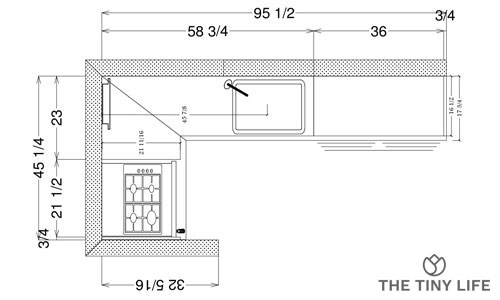
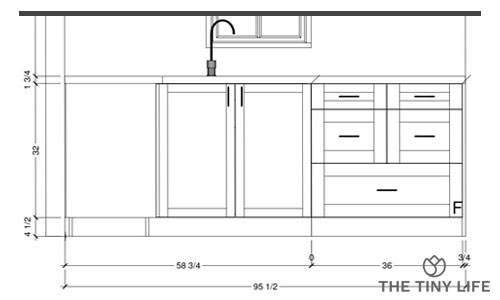
And here are renderings (note the colors changed):
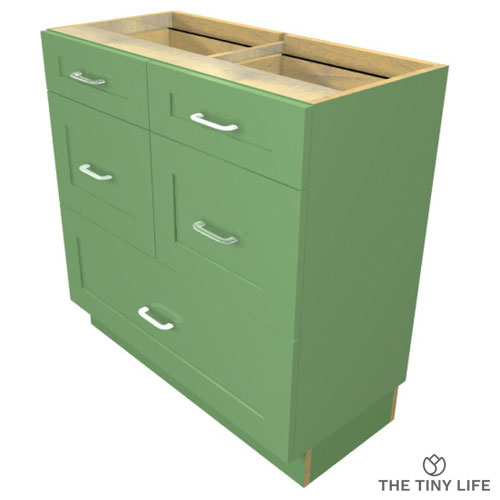
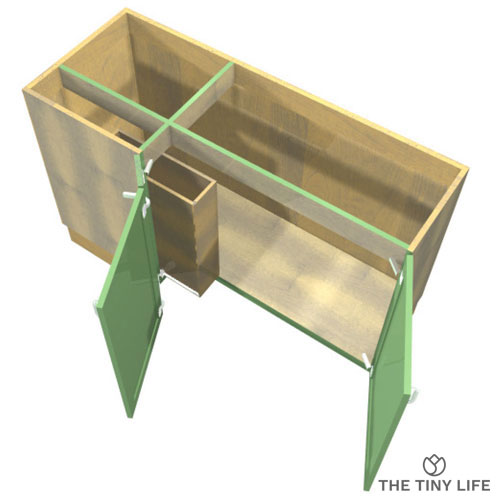
My Tiny House Kitchen

Kitchen Overview
Here is an overview of my tiny house kitchen. You see how it all came together, including my counter space and storage. I found it was important when I was planning to avoid worrying about what I like to call “outlier activities.” For example, people worry they need two ovens to cook Thanksgiving dinner once a year. The rest of the time, they don’t need an extra oven at all. If you’re planning a tiny house kitchen, it’s essential to let go of these outlier activities when space is a premium.
Instead, I find you should only consider what you need for your everyday activities. If you need to cook more food, there are induction burner cooktops available to purchase for under $50. When the time comes for you need to cook a big meal, consider the investment. If it’s worth it, go for it. If not, pass on hosting duties (or ask someone else to bring the turkey).
Here is my stovetop with two burners. This is a Verona stove, which was the only one I could find at the time that was a two-burner (it’s actually meant as an auxiliary cooktop for a larger range). I chose gas/propane, which is better for solar, as electric stoves require so much energy. There was one I looked at made for an RV that was cheaply made and useless. This stove has held up quite well, though, so I’m glad I got it. I like this stove overall, but it burns a little hot.
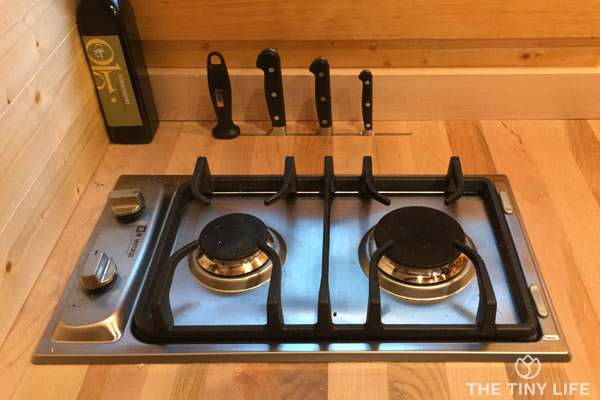
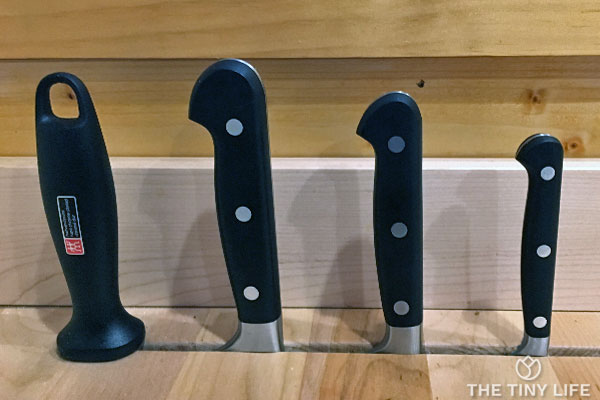 Built-in Knife Block Above Fridge
Built-in Knife Block Above FridgeThis is my built-in knife storage, which takes up very little room on the counter, but keeps my knife set right on hand. This is seriously one of the best decisions I’ve made in my kitchen!
Below, this spot is my fridge. I went with a regular refrigerator-only unit (no freezer). It’s a small, dorm-size fridge, which works for me and my needs. I found a freezer wasn’t necessary, and the freezers in those little fridges didn’t work well anyway. One benefit of not having a freezer is I eat less junk food (Hot Pockets, frozen burritos, pizza rolls, and the like). Since I don’t store ready-to-eat food in my house, I don’t need a microwave either. This saves me quite a bit of space and helps me stay healthy.
If I were to need a freezer for food storage or preservation, I would recommend a chest-type freezer (which you could also keep in a storage shed). Chest freezers are more energy-efficient and run well with solar. There are also other approaches to food storage and preservation, like dehydration, which you may want to experiment with.
My sink is very deep. I wanted a sink to accommodate my pots and pans easily. I also chose this sink because I use it for laundry, as needed. I don’t own a washer and dryer. I HATE doing laundry, and so I pay for a laundry service. For me, it’s worth the investment.
Having a deep sink is quite helpful if you need to wash one shirt or a few pairs of socks quickly. I wash what I need, rinse it out, and hang it up. It’s very functional. The undermount is also nice so I can wipe crumbs right into it and there is no lip to catch anything. You can also throw a cutting board over the top if you need a little extra counter space.
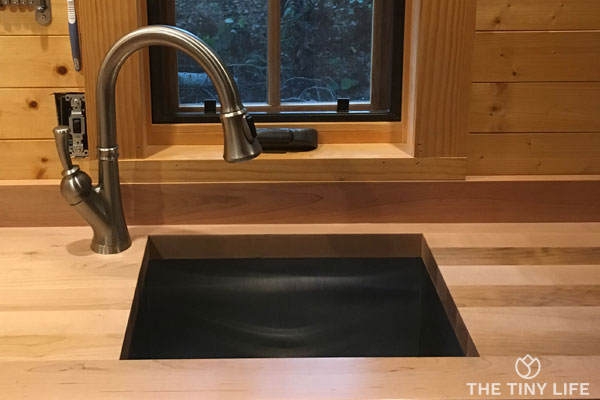
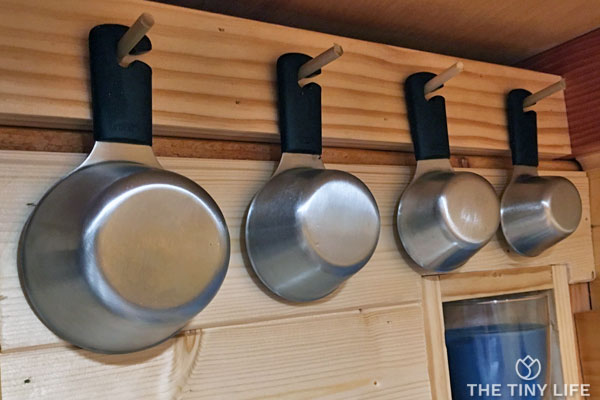
Hanging everyday items like measuring cups is useful, so they’re within your reach at all times. It also keeps them from cluttering up drawers. Find tools that do double duty and you use all the time. Get rid of all those “one-trick pony” items. Chances are you don’t need a waffle iron, fancy chopper, zester, and avocado-pit remover.
This is my spice and dry goods drawer that holds uniform bottles. I keep all my spices here for easy access. I only keep spices and items I use regularly. If a few months go by and I don’t use something, then I know it’s not worth the storage space to keep it.
This rule of thumb goes for most of your food storage. Only keep the food you need for the next week or two (within reason, obviously; condiments and other items may last a little longer). Buy items from bulk bins, where you get only what you need. Buy most items in small quantities, so it’s easier to use it up quickly and you don’t need to store them in your tiny home kitchen.
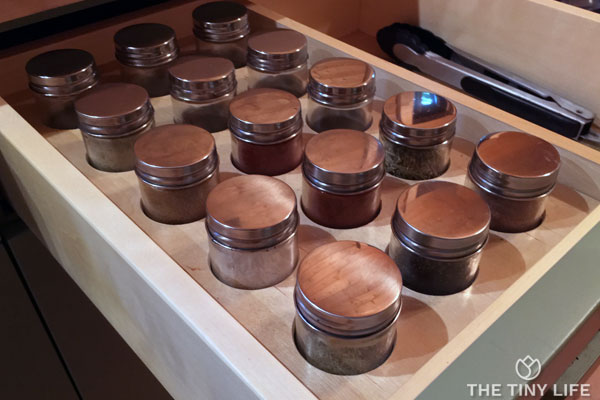
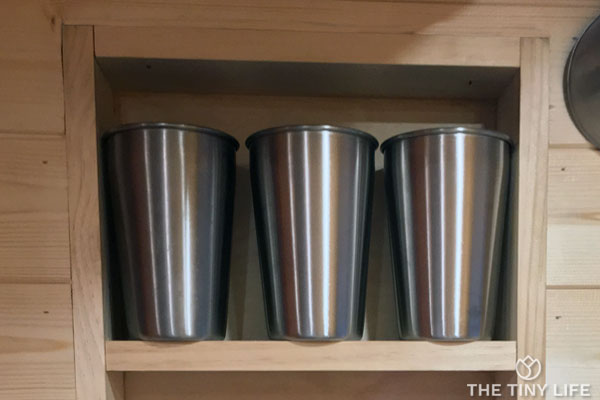
Open concept shelving is used to hold cups and other items I use regularly. I love these metal cups because they don’t break and they will last forever.
I love my counter space. I also like the wooden “butcher block” look for my countertops. They’re maple, sealed with a food-grade polyurethane coating which is going strong even after 7 years! It’s easy to maintain, and I think it looks nice, too. One area to watch on countertops is weight. If you want granite countertops, you may run into a weight concern. Granite counters add about 800 pounds to your trailer, so ensure you factor in the weight.
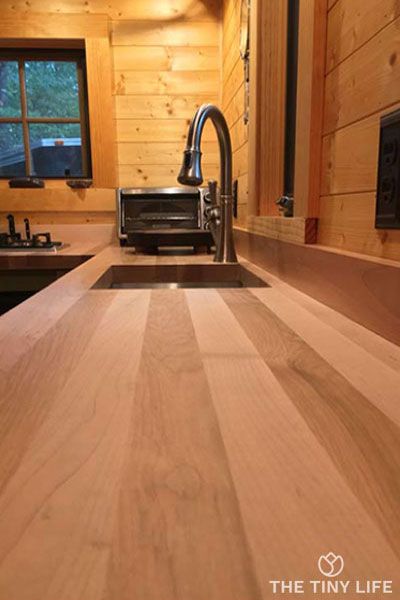
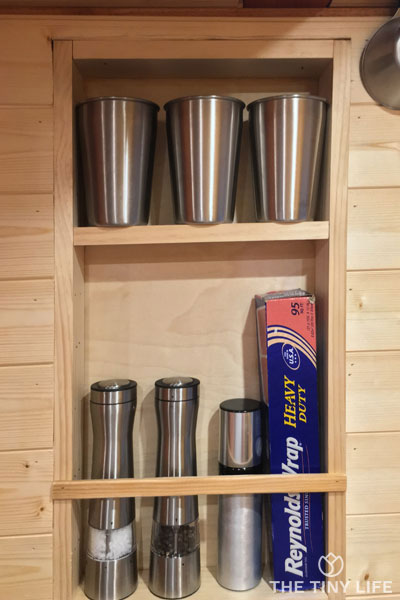
In this other shot of my storage area, you see the salt, pepper, and tinfoil I use so often during food prep and cooking. It’s really nice to keep these items accessible.
I designed these drawers deep enough to hold utensils easily. I only keep exactly what I need and use regularly.
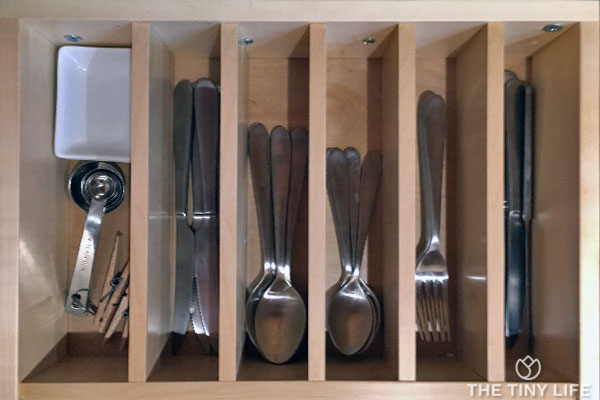
Remember: When it Comes to A Tiny Kitchen, Less is More

I’ve adopted a minimalist mindset when it comes to my kitchen (and life in general). It’s incredible how distilling what you need down to the necessities really brings clarity and helps you feel organized, calm, and less stressed.
When it comes to cooking, I’ve found the simplest way to cook food is to grill. Honestly, I grill a lot! Typically, I’ll put a steak or chicken on the grill 3-4 times a week. Not only is steak delicious (sorry vegetarians), but grilling is so easy to clean up. It keeps the heat outside and there are very few dishes, if any.
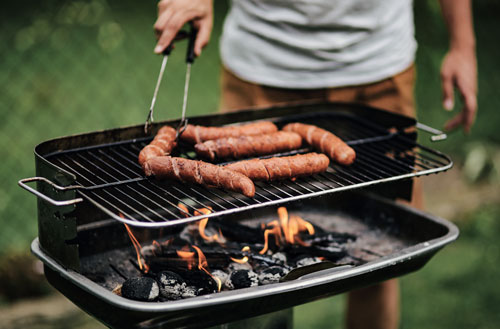 Sometimes I’ll cook a protein on the grill and cook enough for dinner, breakfast, and even lunch the next day. Usually, I eat similar foods, and I buy only what I’m going to eat within the next few days or week. As a result, I don’t often have food that goes bad or gets spoiled. This also helps me save money on food since I’m not buying extras.
Sometimes I’ll cook a protein on the grill and cook enough for dinner, breakfast, and even lunch the next day. Usually, I eat similar foods, and I buy only what I’m going to eat within the next few days or week. As a result, I don’t often have food that goes bad or gets spoiled. This also helps me save money on food since I’m not buying extras.
For most people, their kitchen is the central gathering place in their home. When you live in a tiny house, your whole home becomes the gathering place. Having a tiny house kitchen isn’t challenging, though. I don’t feel like I’m missing out at all with a small kitchen, and I actually enjoy meal prep and cooking more.
When I entertain, friends usually gather around my firepit outside. Some people use pop-up tables and other setups for entertaining, as well. Like I said, it’s important not to plan around those big, once-a-year events for your kitchen. If something does come up, you can always borrow an XXL crock pot from a friend or look up ways to roast your turkey outside. There are plenty of workarounds to make your tiny kitchen functional and enjoyable.
Your Turn!
- What is most important to you in your tiny house kitchen?
- What solutions have you found for cooking in a small space?
I find counter space and light via windows helps with ventilation and overall warmth.
I’m finding it difficult to find a ladder for the loft area. A library ladder takes up too much room in the tiny den. Do they make retractable ladders that can be stashed away and easily pulled out when needed. Thank you.
excellent article! will definitely incorporate these tips into our build. I live in Ontario and own land in a small village north of Toronto. WE have a THOW club of 15 members and our main objective currently is to gather our resources to present to the Town to ask for bylaw changes to allow a THOW common city here.
We are always looking for information from other Tiny House owners how and where they can live .